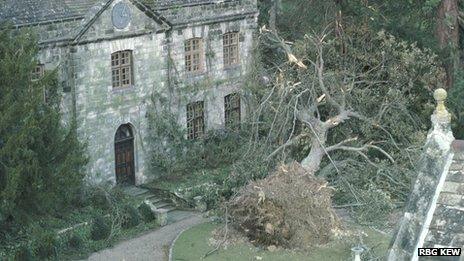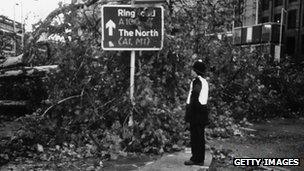25 years on: how Great Storm permanently changed landscape
- Published

Up to 20,000 trees were brought down at Wakehurst Place in West Sussex, many of them over 100 years old
Across large parts of the south east of England the impact of the Great Storm in 1987 is still visible. And for many people who had to cope with the devastating winds and their aftermath, the memories of that night are still vivid. Some have been sharing their recollections with BBC News.
Andy Jackson, head of Wakehurst Place in West Sussex
"At the time of the storm there was a profound sense of shock and disorientation. In parts of the estate 80% of the trees were down, somewhere between 15,000 and 20,000 trees. It took us five years to clear the damage.
"There was a feeling of grief because many of these trees are between 100 and 200 years old - they are so massive and have lived so long that they transcend world wars and other huge events in human history. It took some time for that feeling of grief to pass and for us to think of this as something positive - an opportunity.
"When mature trees are blown over the root system is left up in the air, and it can be 20 to 30ft wide. This has to be cut off so that it's lying on the ground and can then be broken into smaller pieces. In some cases we had to use dynamite to do this.
"Part of the problem was that the terrain at Wakehurst Place is very steep, so we couldn't use cranes to lift the trees. We had to use all-terrain loaders. When all the roots have been cut off there is a solid core about five or six feet wide which needs to be broken up so that it can be moved.
"Once you've removed the tree you then have to re-grade the soil that the roots were sitting in, so that it will be suitable to plant a new one.
"Wakehurst Place is very different now as a result of the storm - but it still has one of the most important tree collections in Britain."
Richard Parry, current Mayor of Sevenoaks
"My recollection of the storm was being woken in the middle of the night by the noise. The cat was mewing loudly outside and when we opened the front door it shot inside - and then the top of a rowan tree that was 30ft from the house also came in.
"I went outside and the noise around the side of the house was incredible. The rain was almost horizontal. Across the garden it looked like every fir tree we had was on its side. A loft hatch had blown off the roof, but there was nothing we could do about it so we went back to bed.
"The following day I tried to take my younger son to school, and there were so many broad trees down you could almost walk along the trunks in order to cross the road. It was absolute chaos. We had no electricity for five days.
"As you know, six of the seven oaks after which the town is named were blown down. They were replaced after an appeal but then one night the saplings were pulled up and the tops cut off. It was probably youth vandalism.
"They have now been replaced so we have eight oaks - the surviving original and seven others that are now about 25ft high. We have also been planting another oak at Britain's Common each year for the past five years, so if there's another storm we should have enough left to still be called Sevenoaks."
John Cope, electricity company worker, Sittingbourne, Kent
"Part of my job was looking for the next fault to fix. After the storm we spent the next three and a half weeks working 18-hour days to rebuild the network. I would be told to go home at 23:30 only to be back at work by 06:00 the next morning.

Falling trees blocked roads across the south east of England
"It was the first time that we had what we call a 'black start', in that the National Grid had to completely shut down to prevent further damage, and then be brought back on in stages.
"As I recall, two people died during this time for a variety of reasons including electrocution. Also trees could collapse at any time, so the job was very dangerous.
"Emergency repairs were made in several cases and permanent repairs went on for many months afterwards. We received help from staff around Britain as well as France to meet the demand to get the electricity back up.
"It was a tremendous effort in a great spirit by all concerned in spite of some unhappy customers. My wife was running a staff canteen at the time and provided food around the clock for office and field staff."
Diane Boyle, was living on Isle of Man
"At the time I was 40 and had been visiting parents in the Midlands. I was returning home on the ferry from Heysham to the Isle of Man when the storm struck. The sailing took almost 12 hours instead of the usual four and a half.
"We were unable to dock at Douglas because of the high seas, and had to kill time sailing up and down the Isle of Man coast until the wind finally abated.
"When I wasn't helping others I took time to go to the covered viewing area at the bow and quite simply enjoyed the thrill of watching the ferry pitch violently up and down.
The only problem was that when we were finally able to disembark I had a distinct wobble on for a while!
Afterwards, I was surprised the ferry actually set sail at all. I would have thought the harbour would have more up-to-date weather forecasts. I think it was a bit of a mistake, especially as the Irish Sea can be very rough."
Richard Mole, was living in Ashford, Kent
"I was 10 at the time and my younger sister and I were woken in the early hours by a pounding on the window and the trees swishing loudly. We both went into mum and dad's bed, but couldn't get to sleep as we could hear smashing and crashing.
"Mum wondered if we should go downstairs and hide under the table. I remember being terrified and the street lights were flashing on and off, presumably due to the intermittent electricity supply - and then hearing this almighty crash.
"We didn't dare go out. The wind died down around 07:00 and we were allowed to go outside about 08:00. We saw that there were branches down in the garden, but nothing had prepared us for the devastation that awaited us outside.
"The neighbours opposite us lost half their roof and our tiles had crashed down on to the next door neighbours' car. Several oak trees had been blown over so the way in to our close was blocked off. A brand new car was squashed underneath them.
When we finally got out of the road I discovered that many of my favourite trees had been destroyed."